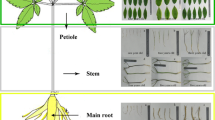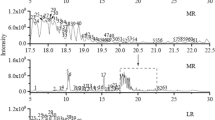Abstract
Notoginsenosides R1, R4, Fa, and K (N-R1, N-R4, N-Fa, and N-K), as well as ginsenosides Rg1, Rb1, Rd, Re, Rf, Rg2 and Rh1 (G-Rg1, G-Rb1, G-Rd, G-Re, G-Rf, G-Rg2 and G-Rh1) in 47 Notoginseng samples including 1-, 2- and 3-year-old main roots, rhizomes and fibrous roots of Panax notoginseng were determined by high-performance liquid chromatography-diode array detection method. Total contents (%) of the 11 saponins were 9.82–14.57 for 2-year old and 14.20–16.00 for 3-year-old rhizomes; 2.72–4.50 for 2-year-old and 1.98–4.92 for 3-year-old fibrous roots; 1.75–3.05 for 1-year-old whole roots; and 3.71–8.98 for 2-year-old and 7.03–11.23 for 3-year-old main roots. Contents of most saponins and total content of 11 saponins were in the order 3- >2- >1-year-old main root samples. G-Rf content, sum of G-Rf and G-Rh1 were, respectively, 0.08–0.18 and 0.14–0.32 for 2- or 3-year-old rhizomes, and 0.01–0.07 and 0.03–0.10 for 2- or 3-year-old main roots. Combined contents of N-R1, G-Rg1 and G-Rb1 were 5.78–9.37 in 3-year-old main roots, and 2.99–7.13 in 2-year-old main roots, of which nearly one-third of samples were lower than the limit (5 %) in the Chinese Pharmacopoeia. Those of 2- or 3-year-old fibrous roots (1.47–3.83) and 1-year-old whole roots (1.41–2.44) were much lower than the limit, and were considered not suitable for use as Notoginseng. Two-year-old main roots are not appropriate for collection as Notoginseng. Different parts and growth years of P. notoginseng can be identified from each another according to differences in saponin content.




Similar content being viewed by others
References
Chinese Pharmacopoeia Committee (2010) Pharmacopoeia of the People’s Republic of China. China Medical Science Press, Beijing, p 11
Ng TB (2006) Pharmacological activity of sanchi ginseng (Panax notoginseng). J Pharm Pharmacol 58:1007–1019
Shen Y, Li YQ, Li SP, Ma L, Ding LJ, Ji H (2010) Alleviation of ovariectomy-induced osteoporosis in rats by Panax notoginseng saponins. J Nat Med 64:336–345
Wang CZ, McEntee E, Wicks S, Wu JA, Yuan CS (2006) Phytochemical and analytical studies of Panax notoginseng (Burk.) F.H. Chen. J Nat Med 60:97–106
Wang XY, Wang D, Ma XX, Zang YJ, Yang CR (2008) Two new dammarane-type bisdesmosides from the fruit pedicels of Panax notoginseng. Helv Chim Acta 91:60–66
Komakine N, Okasaka M, Takaishi Y, Kazuyoshi K, Murakami K, Yoshihide Y (2006) New dammarane-type saponin from roots of Panax notoginseng. J Nat Med 60:135–137
Sun S, Qi LW, Du GJ, Mehendale SR, Wang CZ, Yuan CS (2011) Red notoginseng: higher ginsenoside content and stronger anticancer potential than Asian and American ginseng. Food Chem 125:1299–1305
Liu HL, Xia L, Cao J, Li P, Qi LW (2008) Simultaneous determination of twelve saponins in Radix et Rhizoma Notoginseng by rapid resolution LC-ESI-TOF-MS. Chromatographia 28:1033–1038
Qian ZM, Wan JB, Zhang QW, Li SP (2008) Simultaneous determination of nucleobases, nucleosides and saponins in Panax notoginseng using multiple columns high performance liquid chromatography. J Pharm Biomed Anal 48:1361–1367
Wan JB, Yang FQ, Li SP, Wang YT, Cui XM (2006) Chemical characteristics for different parts of Panax notoginseng using pressurized liquid extraction and HPLC-ELSD. J Pharm Biomed Anal 41:1596–1601
Wang D, Li HZ, Chen KK, Zhang YJ, Yang CR (2005) HPLC comparative analysis of ginsenoside sapinins in different underground parts of Panax notoginseng. Acta Botanica Yunnanica 27:685–690
Toh DF, Patel DN, Chan ECY, Teo A, Neo SY, Koh HL (2011) Anti-proliferative effects of raw and steamed extracts of Panax notoginseng and its ginsenoside constituents on human liver cancer cells. Chin Med 6:4–12
Chan RYK, Chen WF, Dong A, Guo D, Wong MS (2002) Estrogen-like activity of ginsenoside Rg1 derived from Panax notoginseng. J Chin Endocrinol Metab 87:3619–3695
Lee YJ, Jin YR, Lim WC, Park WK, Cho JY, Jang S, Lee SK (2003) Ginsenoside-Rb1 acts as a weak phytoestrogen in MCF-7 human breast cancer cells. Arch Pharm Res 26:58–63
Bae EA, Shin JE, Kim DH (2005) Metabolism of ginsenoside Re by human intestinal microflora and its estrogenic effect. Biol Pharm Bull 28:1903–1908
Liu WJ, Tang HT, Jia YT, Ma B, Fu JF, Wang Y, Lv KY, Xia ZF (2010) Notoginsenoside R1 attenuates renal ischemia-reperfusion injury in rats. Shock 34:314–320
Zou K, Zhu S, Meselhy MR, Tohda C, Cai SQ, Komatsu K (2002) Dammarane-type saponins from Panax japonicas and their neurite outgrouth activity in SK-N-SH cells. J Nat Prod 65:1288–1292
Sun HX, Qin F, Ye YP (2005) Relationship between haemolytic and adjuvant activity and structure of protopanaxadiol-type saponins from the roots of Panax notoginseng. Vaccine 23:5533–5542
Ha SE, Shin DH, Kim HD, Shim SM, Kim HS, Kim BH, Lee JS, Park JK (2010) Effects of ginsenoside Rg2 on the ultraviolet B-induced DNA damage response in HaCaT cells. Naunyl-Schmied Arch Pharmacol 382:89–101
Jung JS, Kim DH, Kim HS (2010) Ginsenoside Rh1 suppresses inducible nitric oxide synthase gene expression in IFN-γ-stimulated microglia via modulation of JAK/STAT and ERK signaling pathways. Biochem Biophys Res Commun 397:323–328
Lee H, Gonzalez FJ, Yoon M (2006) Ginsenoside Rf, a component of ginseng, regulates lipoprotein metabolism through peroxisome proliferator-activated receptor α. Biochem Biophys Res Commun 339:196–203
Liu JH, Wang X, Cai SQ, Katsuko K, Tsuneo N (2004) Analysis of the constituents in the Chinese drug notoginseng by liquid chromatography-electrospray mass spectrometry. J Chinese Pharm Sci 13:225–237
Li J, Wang X, Ma FY (2004) Several factors affecting the HPLC-fingerprinting of Panax notoginseng. Chinese J Nat Med 2:33–41
Acknowledgments
This project was supported by the National Natural Science Foundation of China (grant number 39970898), the National 973 Program Foundation of China (G1999054406), and the National New Drug Discovery and Modernization of Chinese Materia Medica Project (2001BA701A55-3) and the TCM Research Projects of SATCM (200707009).
Conflicts of interest
The authors confirm that there were no conflicts of interest in carrying out this study.
Author information
Authors and Affiliations
Corresponding author
Rights and permissions
About this article
Cite this article
Jia, XH., Wang, CQ., Liu, JH. et al. Comparative studies of saponins in 1–3-year-old main roots, fibrous roots, and rhizomes of Panax notoginseng, and identification of different parts and growth-year samples. J Nat Med 67, 339–349 (2013). https://doi.org/10.1007/s11418-012-0691-6
Received:
Accepted:
Published:
Issue Date:
DOI: https://doi.org/10.1007/s11418-012-0691-6




